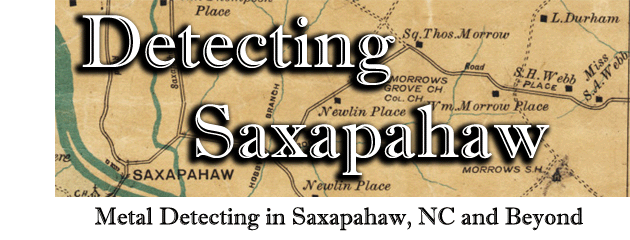Hey everyone! Today’s featured find comes from the Webb Farm on Saxapahaw Bethlehem Church Rd. (now Victory Calls Stables), and it’s a mystery that has nagged me since I started detecting here. It’s a small copper coin-like token, about the size of a nickel. The back is plain, and the front read’s “Foster’s Cafe" around a letter “F” punchout. I’ve searched, but haven’t found any reference to this token online.
Now had I just found the one token, I would probably write it off as a neat unknown find, and not give it too much more thought. But then I found more. Lots more. Nearly thirty of them, all from the same farm field but spread out over several acres. To be fair, most were found within maybe a half acre, but that’s still a sizable area.
What could they be? It has been suggested that they were produced for the modern Foster’s Market Cafe in Chapel Hill, but I think if this were the case I would likely have found some reference to them online. The best lead I have to go on came from the Alamance County Register of Deeds.
When the last of the Webb family, Capt. Sam Webb, died in 1929, the farm was left to his adopted son William Talbert. William sold the property that same year to Richard Freeman Isley and his wife Vivian Foster Isley. The land was sold in 1934 to Vivian's father, Charles Foster, owner of Foster's Hosiery Mill. The land remained in his possession until 1947. Could this be the “Foster” connection in “Foster’s Cafe"?
When the last of the Webb family, Capt. Sam Webb, died in 1929, the farm was left to his adopted son William Talbert. William sold the property that same year to Richard Freeman Isley and his wife Vivian Foster Isley. The land was sold in 1934 to Vivian's father, Charles Foster, owner of Foster's Hosiery Mill. The land remained in his possession until 1947. Could this be the “Foster” connection in “Foster’s Cafe"?
There were several periods of US history during which trade tokens saw increased usage. These included “hard times” tokens issued during silver hoarding in the 1830’s, as well as patriotic small change tokens issued during the Civil War. The heyday of token use in the US came from the 1870’s to early 1930’s, when a surge of small businesses in rural areas created a demand for advertising and merchandise trade tokens. The decline of these tokens began with the Great Depression through the 1940's and 50's. Below is an excellent example of a trade token from the Melville Drug Co. in Mebane dating to the 1920's, recovered by my friend Brad.
So it is possible that the Foster’s who owned this land from 1929-1947 were the connection to these mysterious Foster’s Cafe tokens? Without some further evidence of either the restaurant or the tokens themselves, their origin and age will remain as mysterious as how so many became scattered across a rural Alamance County field. But perhaps some of my readers may be able to assist – if you have any information about Foster’s Cafe of Alamance County, NC please let me know in the comments, on our facebook group, or by email. I am in contact with a token researcher, and will keep you posted on what we find out!
Thanks for reading, and God bless!
Thanks for reading, and God bless!











